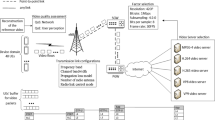Abstract
This paper presents the scheme Heuristic Application Layer Joint Coding (Heuristic-ALJC) for video transmissions aimed at adaptively and jointly varying both applied video compression and source encoding at the application layer used to protect video streams. Heuristic-ALJC includes also a simple acknowledgement based adaptation of the transmission rate and acts on the basis of feedback information about the overall network status estimated in terms of maximum allowable network throughput and link quality (lossiness). Heuristic-ALJC is implemented through two smartphone Apps (transmitter and receiver) and is suitable to be employed to transmit video streams over networks based on time varying and possibly lossy channels. A deep performance investigation, carried out through a real implementation of the Apps over Android smartphones, compares Heuristic-ALJC with static schemes.







Similar content being viewed by others
References
Planete-bcast, inria, ldpc codes download page. http://planete-bcast.inrialpes.fr/article.php3?id_article=16
Bovik AC (2005) Handbook of Image and Video Processing (Communications, Networking and Multimedia). Academic, Orlando
Bursalioglu O, Fresia M, Caire G, Poor H (2009) Joint source-channel coding at the application layer. In: Data Compression Conference, 2009. DCC ’09., pp. 93–102. doi:10.1109/DCC.2009.10
Caldeira J, Rodrigues J, Lorenz P (2012) Toward ubiquitous mobility solutions for body sensor networks on healthcare. IEEE Commun Mag 50(5):108–115. doi:10.1109/MCOM.2012.6194390
Choi Y, Momcilovic P (2011) On effectiveness of application-layer coding. IEEE Trans Inf Theory 57(10):6673–6691. doi:10.1109/TIT.2011.2165130
Fouda MM, Nishiyama H, Miura R, Kato N On efficient traffic distribution for disaster area communication using wireless mesh networks. Springer Wireless Personal Communications (WPC) (2013, to appear)
Gallager R (1962) Low-density parity-check codes. IRE Trans Inf Theory 8(1):21–28
Karimi O, Liu J, Wang C (2012) Seamless wireless connectivity for multimedia services in high speed trains. IEEE J Sel Areas Commun 30(4):729–739. doi:10.1109/JSAC.2012.120507
Katsaggelos A, Eisenberg Y, Zhai F, Berry R, Pappas T (2005) Advances in efficient resource allocation for packet-based real-time video transmission. Proc IEEE 93(1):135–147. doi:10.1109/JPROC.2004.839621
Lloret J, Ghafoor KZ, Rawat DB, Xia F (2013) Advances on network protocols and algorithms for vehicular ad hoc networks. Mob Netw Appl 18(6):749–754. doi:10.1007/s11036-013-0490-7
Martini M, Mazzotti M, Lamy-Bergot C, Huusko J, Amon P (2007) Content adaptive network aware joint optimization of wireless video transmission. IEEE Commun Mag 45(1):84–90. doi:10.1109/MCOM.2007.284542
Shannon CE (1959) Coding theorems for a discrete source with a fidelity criterion. Inst Radio Eng Int Conv Rec 7(part 4):142–163
Silva BM, Rodrigues JJ, Lopes IM, Machado TM, Zhou L (2013) A novel cooperation strategy for mobile health applications. IEEE J Sel Areas Commun 31(9):28–36. doi:10.1109/JSAC.2013.SUP.0513003
Suri N, Benincasa G, Tortonesi M, Stefanelli C, Kovach J, Winkler R, Kohler R, Hanna J, Pochet L, Watson S (2010) Peer-to-peer communications for tactical environments: Observations, requirements, and experiences. IEEE Commun Mag 48(10):60–69. doi:10.1109/MCOM.2010.5594678
Wang Z, Bovik A, Sheikh H, Simoncelli E (2004) Image quality assessment: from error visibility to structural similarity. IEEE Trans Image Process 13(4):600–612. doi:10.1109/TIP.2003.819861
Zhou L, Geller B, Zheng B, Wei A, Cui J (2009) System scheduling for multi-description video streaming over wireless multi-hop networks. IEEE Trans Broadcast 55(4):731–741. doi:10.1109/TBC.2009.2032795
Zhou L, Yang Z, Rodrigues J, Guizani M (2013) Exploring blind online scheduling for mobile cloud multimedia services. IEEE Wirel Commun 20(3):54–61. doi:10.1109/MWC.2013.6549283
Zhou L, Yang Z, Wen Y, Rodrigues J (2013) Distributed wireless video scheduling with delayed control information. doi:10.1109/TCSVT.2013.2291311
Author information
Authors and Affiliations
Corresponding author
Rights and permissions
About this article
Cite this article
Bisio, I., Lavagetto, F., Luzzati, G. et al. Smartphones Apps Implementing a Heuristic Joint Coding for Video Transmissions over Mobile Networks. Mobile Netw Appl 19, 552–562 (2014). https://doi.org/10.1007/s11036-014-0519-6
Published:
Issue Date:
DOI: https://doi.org/10.1007/s11036-014-0519-6




